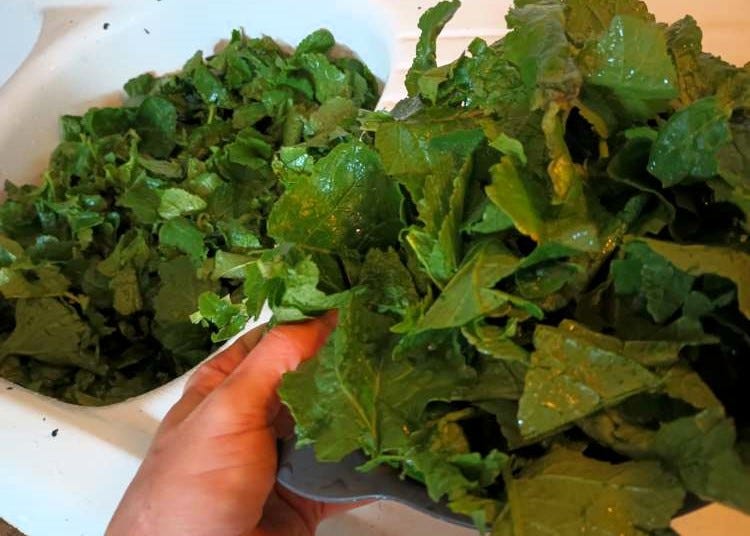2023 in Review
How did our garden grow?
Even though it’s off-season for us, we spent a little time at the farm this week. We still had one bed that was exposed to the elements — it was our sweet potato row, which we harvested last — and so it was at risk for erosion and for hardy weeds sticking around until spring. And it was while finagling the tarps into place to cover the whole field in what must be the worst real-life jigsaw puzzle ever, maneuvering around stumps of former trees and trip-happy plugs of vegetation that had sprung up on our walking paths, that we made a discovery.
Those clumps of wild vegetation we were dodging? They were renegade radish and turnip plants. Some had bolted into pretty yellow flowers, but a quick chomp on the leaves revealed they weren’t too bitter.
And so began the harvest of either our first 2024 crop or our final 2023 one.
As we cook that mess of greens down for several gleaned meals this week, it’s a good time to look at the final harvest numbers for last year.
First the high-altitude view: We’ve always grown about 1000 pounds of food on our little tract. But always just under 1000.1 This was the year we anticipated needing summer flexibility, so we planned lower-maintenance crops (nothing in the ground that would need weeding or washing, bush varieties of tomatoes and beans, that sort of thing). We were ready for reduced yields.
We got more. We cracked 1000. We harvested 1000⅓ pounds, to be exact. Excluding the “wild-caught” greens we pulled out this week.
Dialing down a little bit:
We did grow fewer tomatoes. We didn’t even plant our beloved sungold cherries, because they’re so much work to harvest. And we switched from pest-resistant stalwart slicing tomatoes (Galahad and Skyway varieties) to a Dwarf Tennessee Suited, which weren’t supposed to require trellis or shade tunnel. In fact, they did need trellising, and they proved far less resistant to disease. We gathered 151 pounds of tomatoes in all, down from 292 pounds the previous year.
Our numbers were bolstered this year by our row of spaghetti squash, which were low maintenance and high yield. Those vines kicked out 279 pounds of squash. The down side is, based on the amount of space they take up, we had to charge more than many customers were willing to pay. Growing organically is important to us, and it should be to customers, but is it reasonable to expect a shopper to pay 3 or 4 times market price for them? Next year we are likely to only grow enough of these for ourselves.
We experimented with growing popcorn amidst our black beans, and that was a huge success. The two crops proved perfect roommates, giving us two rows of crops in one row’s space. Once the corn cobs had dried and the kernels removed, we had 15 pounds of white popcorn.
God bless our Little Leaf Cucumbers. Those babies just kept churning out delicious cucumbers like a bunch of Little Engines That Could. We harvested about 164 pounds of them, down only marginally from 189 last year, but with about 25-percent fewer plants. We also stayed ahead of the pickleworms this year with our organic pesticides and got more veg per capita.
The last big surprise were ground cherries, which were easy to grow, less easy to harvest, but an amazing tasty surprise. We talked plenty about these sweet tomatillo relatives in our mid-year State of the Farm report. We ended up harvesting nearly 13 pounds of fruit with no oversight.
We also did a lot of planting for the future. We added 14 fruit trees through the entire western swath of the farm, adding to the dozen or so that were already there. We’ve got apples, cherries, pears, persimmons, peaches, apricots, figs, plums … and olives (!) in the ground. Hopefully the biggest of those will bear fruit this year.
And growing aside, we spent a good deal of time last year on farm improvements and beautification efforts. We were able to tuck away the stacks of shade-tunnel PVC that were piled on the side fence, finish rehabilitating a sheet-metal garage as a barn, and plant a series of shrubs and flowering bushes along the street, outside of our fence, on what Jenn affectionately used to call The Hellstrip.
Over the next six weeks, we’ve got a few more improvement projects in store (which we’ve given exciting code names like “fence additions” and “fence replacements” and “stump removal”) while Jenn begins drawing up our planting plan for the spring.
But in the words of a wiser man:
In seed time learn, in harvest teach, in winter enjoy.
— William Blake
We’ll dust off the ol’ spreadsheet soon enough. We’ve got a few more cozy nights by the fire before then.
Almost always. There was 2020, where we had a bounty of collards, huge clusters of cabbage, and a bumper crop of tomatoes, bolstering the numbers to 1,400 pounds. But that was an anomaly. We planted two fields that year, which was a mistake, in that it didn’t double our production and almost killed the farms entire staff of two.



Can I just say how much I love your combo of plant talk and assessment metrics, Brad? Nerd alert! Maybe I missed a calling to go into Agriculture. . .